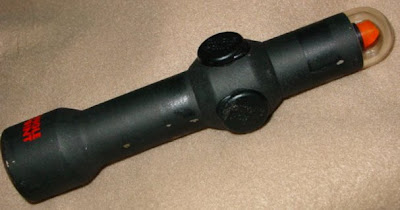The Art Of The Rifle, by Jeff Cooper
There are many books about how to shoot a rifle. There are some excellent ones written about target competitions and how to win them. There are also many military manuals explaining the rifleman's role in combat. The Art of the Rifle is something else again. It takes up the general subject of field marksmanship, whether for hunting or fighting, which may be summed up as the problem of addressing fleeting targets. Accuracy is essential, of course, but Cooper also underlines the need for all practical speed.
is something else again. It takes up the general subject of field marksmanship, whether for hunting or fighting, which may be summed up as the problem of addressing fleeting targets. Accuracy is essential, of course, but Cooper also underlines the need for all practical speed.


 I was, therefore, surprised to see a detailed treatment of the formal firing range positions--prone, sitting and so on, and the use of the sling. But there is an unusual wrinkle here, the use of a "speed sling" to get you tied to the rifle faster than is possible with the traditional loop sling. The problem of adapting the target range positions to field conditions of terrain and cover is given due treatment, with the suggestion that you may modify the positions to suit varying situations. The use of field rests, which most hunters would prefer to looping up in a sling, gets thorough coverage too.
I was, therefore, surprised to see a detailed treatment of the formal firing range positions--prone, sitting and so on, and the use of the sling. But there is an unusual wrinkle here, the use of a "speed sling" to get you tied to the rifle faster than is possible with the traditional loop sling. The problem of adapting the target range positions to field conditions of terrain and cover is given due treatment, with the suggestion that you may modify the positions to suit varying situations. The use of field rests, which most hunters would prefer to looping up in a sling, gets thorough coverage too.
Some of the information is cursory at best. The chapter on windage, for example, takes up a page and a half and could as well have been omitted. It says, essentially, that you needn't worry about the wind at typical hunting distances, then offers that heavier bullets drift less than lighter ones.
Likewise, the information on compensating for distance is decidedly sketchy. The assumption is the field shooter will shoot a fixed zero and will not adjust his sight for varying ranges. If necessary he will hold a bit high or low to make do with the zero he has. This is, indeed, the policy of almost all American hunters, but I would have liked some information on the alternative.
On the other hand, sighting in, aiming and trigger control--and all the other essential and basic points, really-- are thoroughly presented in a clear and engaging style. The portion on trigger control is particularly good. The book contains a number of clear photographs that help get its points across.
All in all, the book is written to address the problem of shooting at moderate distances efficiently, which is certainly a fine skill to have. The Art of the Rifle trims out a lot of material you find in other books, that is more or less extraneous to basic competence afield. It gives most riflemen, perhaps, all the information they need.
trims out a lot of material you find in other books, that is more or less extraneous to basic competence afield. It gives most riflemen, perhaps, all the information they need.
Some of the information is cursory at best. The chapter on windage, for example, takes up a page and a half and could as well have been omitted. It says, essentially, that you needn't worry about the wind at typical hunting distances, then offers that heavier bullets drift less than lighter ones.
Likewise, the information on compensating for distance is decidedly sketchy. The assumption is the field shooter will shoot a fixed zero and will not adjust his sight for varying ranges. If necessary he will hold a bit high or low to make do with the zero he has. This is, indeed, the policy of almost all American hunters, but I would have liked some information on the alternative.
On the other hand, sighting in, aiming and trigger control--and all the other essential and basic points, really-- are thoroughly presented in a clear and engaging style. The portion on trigger control is particularly good. The book contains a number of clear photographs that help get its points across.
All in all, the book is written to address the problem of shooting at moderate distances efficiently, which is certainly a fine skill to have. The Art of the Rifle


Comments
Post a Comment